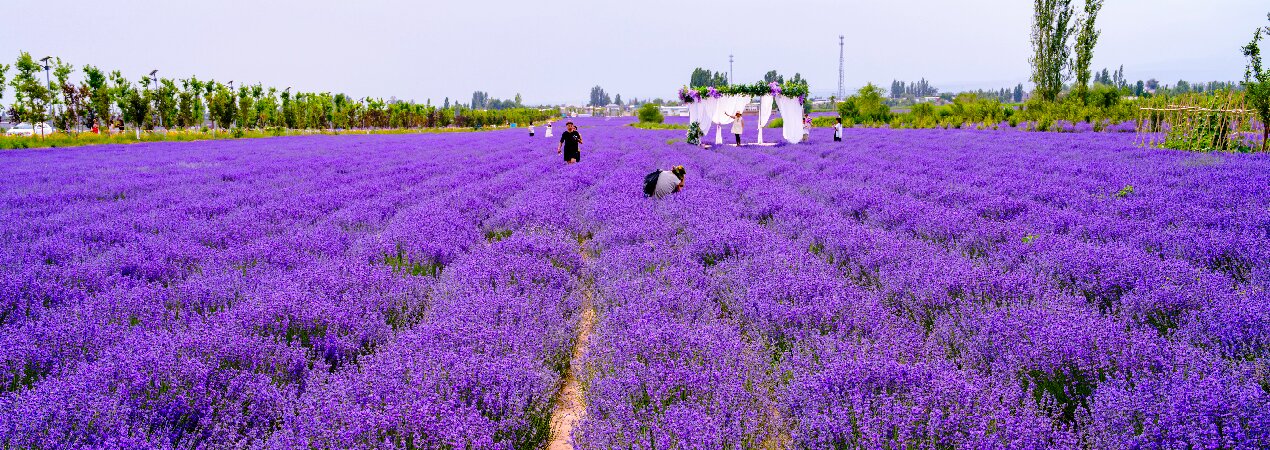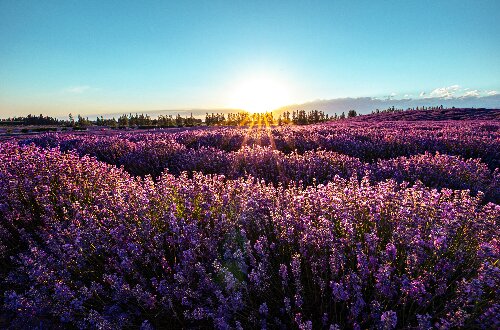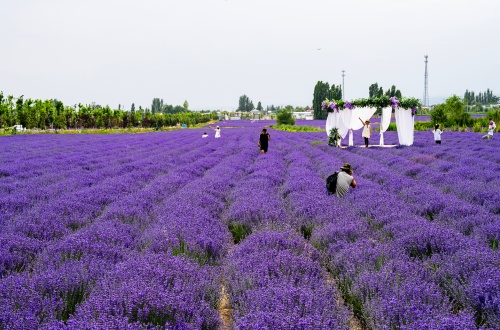Huocheng Lavender

Huocheng County, Ili Prefecture, Xinjiang, is known as "China's Hometown of Lavender". The lavender-growing region in Huocheng lies at the same latitude as Provence, France, with similar climatic and soil conditions. It is the largest lavender planting base in China, and lavender from Xinjiang has been listed among the world's eight renowned lavender varieties.
- Chinese name: 霍城薰衣草 Huò Chéng Xūn Yī Cǎo
- Suggested time: 1.5 - 3 hours
- The best time to visit: June - July
- How to get there: It is recommended to travel by self-driving, which will be more convenient
Jieyou Princess Lavender Garden
 Jieyou Princess Lavender Garden
Jieyou Princess Lavender GardenThere is a lavender field with a broad view in the garden. A variety of colorful flowers are planted in long strips across the flower field, with blooms of different colors staggered in rows, creating a stunning sight. Scarecrows, flower archways, windmills, sculptures and other decorations are also set up among the flower fields. In addition, the garden is home to a lavender museum, an essential oil factory, distillation furnaces, a lavender variety garden, and an apricot orchard. The museum offers several unscheduled guided tours every day, allowing you to learn more about lavender through these explanations.
- Ticket: 35 yuan per person. The charging standard shall be subject to the on-site announcement
- Open hours: 09:00 - 21:00 (admission stops at 20:30)
- Address: Near State Road 218, Qingshuihe Town, Huocheng County, Ili Kazak Autonomous Prefecture
Manxin Wangyou Valley Scenic Area
Manxin Wangyou Valley covers an area of 10,960 mu. The scenic area mainly includes a newly-built lavender viewing and tourism zone, flower fields, forest valley homestay areas, a research base, and a parent-child park, among other facilities. It also develops lavender essential oil processing products. This is a tourist attraction integrating multiple functions such as sightseeing, farming experience, homestay wellness, research and popular science, and parent-child recreation.
- Ticket: Free
- Opening hours: 10:00-21:00
- Address: Yuanbaoshan Village, Lucao Valley Town, Huocheng County, Ili Kazak Autonomous Prefecture
Sigong Village Lavender Flower Sea
The lavender river in Sigong Village stretches 310 meters. Lavender here blooms twice a year, so this romantic "purple river" can be admired from June to mid-July and from early September to early October. Both in summer and autumn, visitors can experience the romantic life amid the lavender sea.
- Ticket: Free
- Recommended visiting hours: It is advisable to visit from 8:00 to 10:00 in the morning, when the light is clear and there are fewer tourists
- Address: Behind the mountain, Group 3, Sigong Village, Lucao Valley Town, Huocheng County, Ili Kazak Autonomous Prefecture
Huanghuang Village Lavender
 Huanghuang Village Lavender
Huanghuang Village LavenderIt is one of the most romantic spots in the Ili River Valley. The lavender fields here are more niche and tranquil, maintaining an original ecological style. Entry to some farmlands costs 10-20 yuan. There is a unique café beside the lavender fields, where visitors can enjoy the flowers while sipping coffee. Local farmers also sell affordable lavender by-products such as dried lavender and essential oils.
- Ticket: Entry to some farmlands costs 10-20 yuan
- Recommended visiting times: Mornings from 8:00 to 10:00 are ideal, with clear light and fewer tourists; evenings from 19:00 to 21:00 are equally charming, as the flower fields take on a golden-purple glow under the setting sun, creating a thoroughly romantic atmosphere
- Address: Huanghuang Village, Huocheng County
Educational Value
The aroma of lavender comes from the volatile oils it contains, such as linalool and linalyl acetate, which have sedative, antibacterial and other effects. Explaining the process of extracting essential oils through distillation (such as using common distillation furnaces) can intuitively demonstrate chemical principles like mixture separation and material phase change. Meanwhile, it can be linked to application scenarios in the development of natural products, including the fields of fragrances, cosmetics and pharmaceuticals.
Drop us a line and we'll connect you with the top China expert in no time!